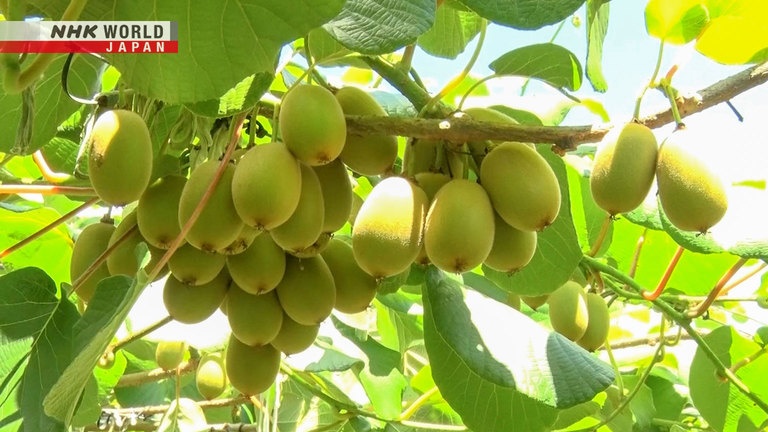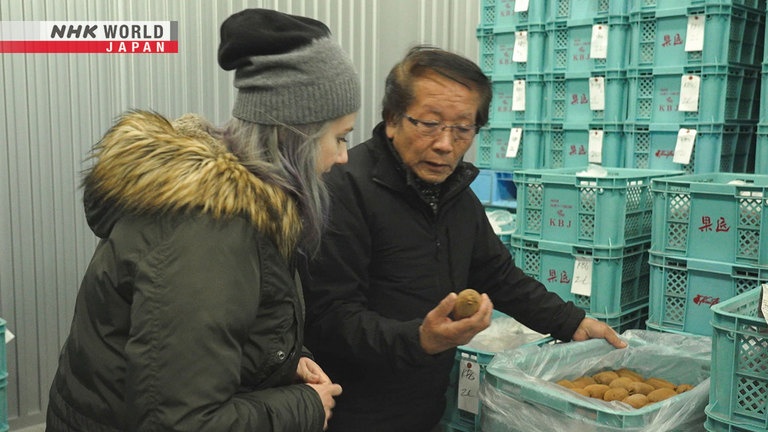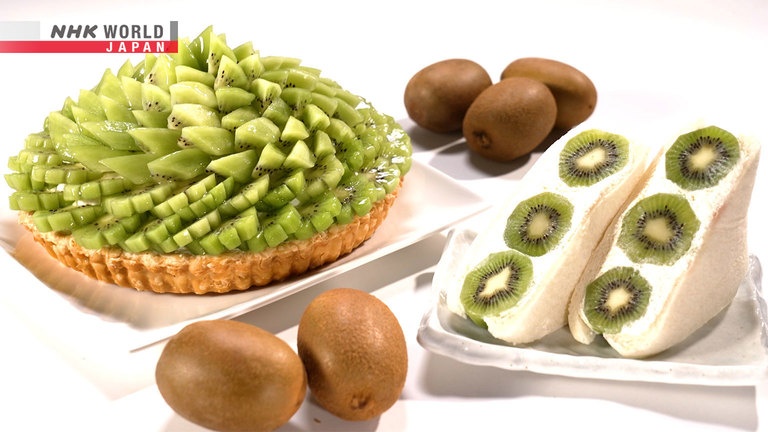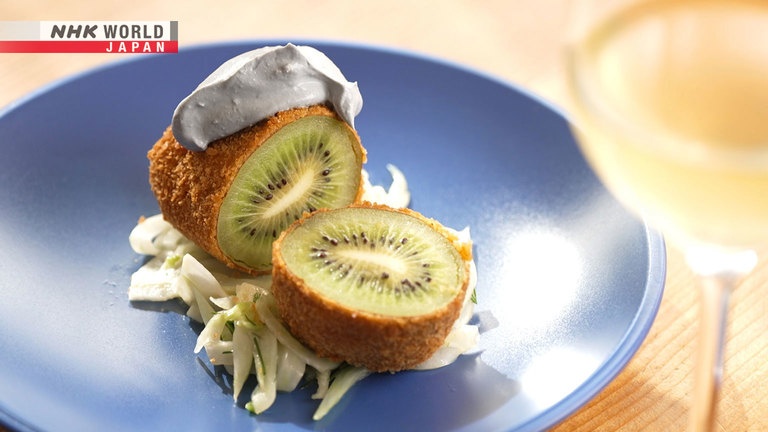KIWI
The key to tasty kiwi is a ripening process that takes place after harvest. Discover new varieties being developed in Kagawa Prefecture and feast your eyes on innovative dishes. (Reporter: GOW)




Transcript
Tokyo: this world-class metropolis is a veritable gourmet wonderland.
Discover the stories behind the ingredients that make this city so delicious - so "oishii."
Today we look at kiwi.
It's only been cultivated on a grand scale for about 100 years.
Its lovely appearance and flavor make it great for desserts.
Packed with goodies like vitamin C and fiber, kiwi is quite the super fruit.
Also, many varieties have been produced in Japan over the years.
They can be this small?
The fruit's blend of sweet and sour offers endless possibilities.
What on earth is this?
With kiwi, there's more than meets the eye.
Hi. Want some kiwi?
Trails to Oishii Tokyo.
Hi, everyone. My name is GOW and I am from the UK and Philippines.
When you hear the word kiwi fruits, what comes to your mind?
For me, it's a very beautiful green color that is on desserts.
But in this episode, you and me both might just be in for a big surprise.
GOW begins at a shopping center next to the famous scramble crossing outside Shibuya Station.
She'll try a sweet that's quite popular in Japan.
Oh, and there they are! Look at these colorful, yummy-looking rice cakes.
Traditional daifuku sweets with whole pieces of seasonal fruit wrapped in the center.
The shop typically offers around 10 choices.
Wow, so big!
Before eating, cut the sweet in half using a dedicated string.
Nice! That worked well!
It's a beautiful, beautiful green color.
Kiwis are popular because their
cross sections look so lovely.
Time for a taste test.
Very fresh and sweet.
The kiwi is covered with sweet white bean paste, and a soft rice cake known as gyuhi.
It's quite flavorful.
The gyuhi and bean paste aren't
overly sweet, so the kiwi flavor stands out.
- It's perfect.
- Thank you.
We used Hayward kiwi from New Zealand.
The Hayward kiwi was developed in New Zealand.
It's the most widely distributed kiwi - the familiar green kind found all over the world.
Quiz time: does anyone watching this know when kiwi season is?
Let's ask around Shibuya.
- Summer?
- Not spring?
Summer?
That's when I see them in fruit shops.
Summer?
That's when I usually eat them.
Most people guessed summer.
Is that right?
I say summer.
- Because it looks tropical.
- That's true.
Answer: Winter.
The opposite.
In Japan, kiwi is commonly mistaken as a summer fruit, but its history offers a reasonable excuse.
The kiwi originated in China.
It was a variety called mihoutao mainly used for medicinal purposes.
In 1904, a teacher from New Zealand named Mary Isabel Fraser
brought the fruit back home with her after traveling to China.
Selective breeding back in New Zealand led to the tasty Hayward variety.
The fruit was named after New Zealand's native bird, the kiwi.
Don't they look alike?
Kiwis were first exported to Japan for consumption in 1964.
It's winter in the southern hemisphere when kiwis are in season,
but it's summer in the northern hemisphere, where Japan is.
This could explain why people consider kiwi a summer fruit in Japan!
Japan ranks 12th in global kiwi production, with a large output considering the country's size.
GOW heads to Ota Market in Tokyo to find domestic kiwis.
There's another fruits over here.
- Good morning.
- Good morning.
This wholesaler mainly handles high-end fruits grown in Japan.
I'm looking for kiwi today.
We have some.
Could you show me?
They all look different.
- We have four varieties today.
- I see.
Take a look at this.
This is the kiwi fruit that I know... but not, because this is the ones that I know... usually.
It's different.
- This is longer.
- Because of selective breeding in Japan.
These are kiwis?
They're big!
It looks like a potato!
These are size 3L.
They can get up to 6L.
Sanuki Gold are among the largest in the world.
Kiwis vary in size and shape by variety.
Sanuki Angel Sweet kiwis are relatively new, introduced about a decade ago.
How does that look?
Lovely colors!
How about Sanuki Gold?
Very easy to cut.
It does look a bit gold.
A very refreshing, sweet scent.
The aroma is very nice.
I want to eat it with a spoon.
So how do we know if a kiwi is ready to eat?
He'll teach GOW how to check.
Press the top and bottom.
If it feels a bit soft, it's ready to eat.
- This one is still hard.
- May I?
You're right.
Pushing the sides will cause it to spoil.
Only press the top and bottom.
If you put them in a bag with apples,
they will get softer.
Why apples?
Place firm kiwis in a bag with apples at room temperature.
The ethylene gas emitted from apples will help the kiwis ripen.
Where should I go to learn more?
You should go to Kagawa.
Kagawa Prefecture?
Many new varieties are coming out of Kagawa.
You should go check it out.
Will do.
The three varieties GOW saw today all came from Kagawa.
Kagawa kiwis are said to be even sweeter than Haywards.
Let's compare regions in Japan by production volume.
Ehime is number one, with Fukuoka at number two.
Kagawa, Japan's smallest prefecture, ranks 11th.
However, Kagawa has registered 11 kiwi varieties, the highest number in Japan.
Next, GOW heads to Zentsuji, Kagawa, 570 kilometers west of Tokyo.
So, I have heard that there's a rare festival happening over here, so let's go out and check it.
As you can see, I think this is the place.
Found one!
Kiwi drinks.
A kiwi festival was held for the first time this year to promote the town's pride and joy - kiwi.
Twenty-seven shops participated, offering all kinds of tasty treats.
- Pickled kiwi?
- Yes.
- This is just pickled, no additives.
- I see.
- Pickled for six days.
- Six days?
We tried pickling them in shochu liquor.
- More than just a fruit, it's a great snack. Quite refreshing.
- Right.
This chicken was marinated
in garlic and kiwi, then grilled.
I have no idea what it's gonna taste, but let's give it a try.
Surprisingly, it does not fight with the actual taste itself.
I didn't think you could cook
kiwi with meat, but this is great.
The kiwi actually helps tenderize the chicken.
- Kiwi has that role as an ingredient?
- Exactly.
This is because of an enzyme called actinidin found in kiwi.
Try covering prosciutto ham with grated kiwi.
In two hours...
The meat practically melts when touched with chopsticks.
Kiwi tenderizes meat and aids with digestion.
GOW finds some fresh kiwis for sale.
- Hi.
- Hello.
So many varieties.
They can be this small?
Yes, it's one of the world's smallest types.
The smallest?
It really is small!
Hold it like this, and make several
small incisions with your thumbnail.
Oh, it's dripping juice!
Then you can break it in half.
Nice and easy!
- Squeeze it and suck the meat out.
- Got it.
Itadakimasu.
Look at the juice!
It's so tasty! And sweet!
The sweetness level is over 18 degrees Brix.
Delicious. I didn't know they could taste this way.
Shimada grows eight Kagawa varieties on his farm.
When was the first kiwi grown in Japan?
I think it was in the 70s.
This area used to farm mikan oranges,
but business became difficult after prices fell.
Farmers found kiwi when looking for an alternative.
As both fruits are suited to warm climates,
kiwi cultivation was introduced in the region to replace mikan oranges.
Breeding research in Kagawa has led to many unique kiwi varieties over the years.
At 29 years old, Shimada began working on his father's farm in 1978.
Mikan oranges and loquat fruits were the main crops at the time.
Then, after tasting the regional Koryoku kiwi, he switched gears to kiwi farming.
GOW gets a tour of the farm.
- Here?
- Yes, my beloved farm.
The sun is welcoming us!
She arrived in December, when she thought kiwis would be in season.
But where is the fruit?
They're in season, so where are the kiwis?
December is when they are consumed.
Kiwis are harvested in November.
They are ripe and ready to eat after harvest?
No, you can't eat them right away.
Kiwis actually don't ripen on their own, whether on the tree or post-harvest.
I'll be adventurous and take a bite.
But the color looks right.
- The color itself is green.
- Yeah.
- Sour!
- Right?
Let's see what happens to unripened kiwis after harvest.
Large ones like Sanuki Gold and
Koryoku are sorted using this machine.
Here?
The machine sorts the harvested kiwis into 10 groups by size.
Then, they're placed in a large cooler.
It smells sweet!
What's the temperature in here?
It's set to around 4 degrees Celsius.
The farm has five cooling rooms.
Some can store up to 60 metric tons of kiwis.
- We keep them like this.
- Very organized.
Everything is just the same size.
- Feel it.
- Thanks.
- It's hard, right?
- Yes.
If they aren't stored this way,
they won't last until March.
Keeping them hard helps them last.
When we receive an order for kiwis,
we take those out of this cooler.
Then, we soften them in a ripening process.
So this is not the final product.
Ethylene is used in the ripening process - similar to how kiwis are kept in a bag with apples.
Typically, kiwis are shipped along with ethylene-producing products to facilitate ripening,
but they may not ripen evenly.
Shimada's farm does things a bit differently.
These are covered.
We cover the crates with polyethylene sheets
and pump ethylene gas into them.
Ethylene gas is evenly distributed to ripen the kiwis in time for shipment.
Ethylene amount, temperature, humidity, and other factors
are adjusted carefully depending on kiwi size, variety and condition.
The kiwis are ripened to meet client needs before being shipped out.
Ripening is when carbohydrates
are converted to fructose.
Some varieties take up to 10 days.
Oranges and apples can be shipped
and eaten directly after harvest.
Kiwis are different.
We need to make sure they are ready
to eat before they are shipped.
GOW tries some kiwis that've finished ripening.
Lovely green color.
Lots of seeds. Is that a good sign?
The more seeds, the better it tastes.
Time to taste Koryoku, Shimada's pride and joy.
"Oishii."
Mild yet rich, with a refreshing aftertaste.
How interesting!
- I'd say it's delicious rather than just sweet.
- I see.
There's umami along with the sweetness.
Now for the world's largest - Sanuki Gold.
It's soft!
That's the key trait.
A soft variety.
- Different from other kiwis. Very little acidity.
- Right.
It's sweet and quite juicy.
Juicy varieties have an impactful flavor
even though sugar content is relatively low.
Choosing the right fertilizer is also key.
Customers always come back for tasty kiwi,
and amino acids influence that flavor.
Shimada experiments with amino acid-rich fertilizers,
such as by mixing crab and shrimp shells.
He aims to produce kiwis that fetch over 10 dollars per fruit.
Gotta make it pretty first.
Lovely.
After harvest, kiwis are inspected up to five times!
Shimada's crafted kiwis are a hit with high-end fruit shops and five-star hotels across Japan.
I work every day of the year.
But the farm is my happy place.
My family wants me to take a day off.
Back in Tokyo, GOW heads to a restaurant in a residential area.
- Hello.
- Hi.
Cooking with kiwi isn't so common,
so today will be full of surprises.
Iimura has been cooking French cuisine professionally for 20 years.
With kiwi, he's developed a unique menu.
He's preparing a Koryoku kiwi from Kagawa.
It'll be cooked with the skin intact.
Here you are.
What on earth is this?
A kiwi fried whole.
- Fried kiwi?
- Precisely.
Cooked kiwi is a first for me.
I've never had anything like this.
What's on top?
A goat cheese puree.
It's steaming hot.
- Tasty. Very interesting.
- Pretty unique.
I thought that if you fried the fruit itself that it would be a little more sweeter,
but no, it's a different one.
It has a little more sourness that is really impact.
It gives a really big impact to you.
The creamy goat cheese provides a nice balance.
How did you come up with this idea?
I saw my friend from New Zealand
eating a kiwi whole, with the skin.
That surprised me.
I didn't know you could do that.
Using the skin, which is often thrown out,
adds fiber to dishes.
Also, vitamin C will cook out
if you heat kiwis too long.
Frying them whole keeps the center rawer,
so the vitamin content is maintained.
Impressive.
Dish number two.
Here we go.
One moment!
It's so beautiful.
Lovely.
A work of art!
Kiwi tartar with lamb sausage.
He used the small kiwi variety we saw back in Kagawa.
Avocado, asparagus, coriander and bananas are also used, offering lots of texture.
On top is a processed jelly sheet made of five sauces, including wasabi and yuzu pepper.
Heat from the dish melts the sheet into a sauce.
Enjoy all of the flavors together,
along with the sausage and tartar.
This is kiwi? It is!
Lamb and kiwi go great together!
- It's a bit milder than the first kiwi.
- It is.
I suppose chopping the kiwi into small pieces
allows its flavors to wrap around the meat.
Exactly.
Lamb dishes outside Japan often come with
coriander, yoghurt, and things like candied lemon.
I tried using kiwi instead of lemon.
It plays a similar role in terms of flavor.
What do you like best about using kiwi?
I see it as a great gift to chefs.
You have sweet, sour and bitter all in one fruit.
That makes it pretty versatile.
- You can rely on kiwi!
- Right.
I'm impressed. I'm a fan of kiwi now.
Yeah, I'm with you.
I was quite skeptical coming into this episode because, for me, kiwi was only a fruit.
But throughout, I have found that it has high potential and so many possibilities.
I encourage everyone to eat more kiwi and find your own discovery.
In Tokyo, every ingredient has its own story.